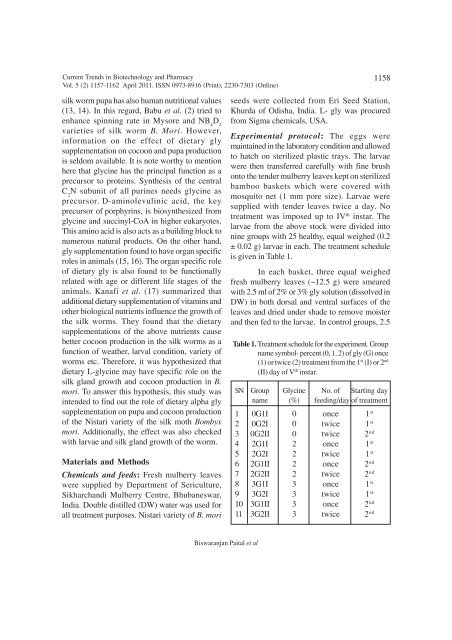full issue - Association of Biotechnology and Pharmacy
full issue - Association of Biotechnology and Pharmacy
full issue - Association of Biotechnology and Pharmacy
- No tags were found...
You also want an ePaper? Increase the reach of your titles
YUMPU automatically turns print PDFs into web optimized ePapers that Google loves.
Current Trends in <strong>Biotechnology</strong> <strong>and</strong> <strong>Pharmacy</strong>Vol. 5 (2) 1157-1162 April 2011. ISSN 0973-8916 (Print), 2230-7303 (Online)1158silk worm pupa has also human nutritional values(13, 14). In this regard, Babu et al. (2) tried toenhance spinning rate in Mysore <strong>and</strong> NB 4D 2varieties <strong>of</strong> silk worm B. Mori. However,information on the effect <strong>of</strong> dietary glysupplementation on cocoon <strong>and</strong> pupa productionis seldom available. It is note worthy to mentionhere that glycine has the principal function as aprecursor to proteins. Synthesis <strong>of</strong> the centralC 2N subunit <strong>of</strong> all purines needs glycine asprecursor. D-aminolevulinic acid, the keyprecursor <strong>of</strong> porphyrins, is biosynthesized fromglycine <strong>and</strong> succinyl-CoA in higher eukaryotes.This amino acid is also acts as a building block tonumerous natural products. On the other h<strong>and</strong>,gly supplementation found to have organ specificroles in animals (15, 16). The organ specific role<strong>of</strong> dietary gly is also found to be functionallyrelated with age or different life stages <strong>of</strong> theanimals. Kanafi et al. (17) summarized thatadditional dietary supplementation <strong>of</strong> vitamins <strong>and</strong>other biological nutrients influence the growth <strong>of</strong>the silk worms. They found that the dietarysupplementations <strong>of</strong> the above nutrients causebetter cocoon production in the silk worms as afunction <strong>of</strong> weather, larval condition, variety <strong>of</strong>worms etc. Therefore, it was hypothesized thatdietary L-glycine may have specific role on thesilk gl<strong>and</strong> growth <strong>and</strong> cocoon production in B.mori. To answer this hypothesis, this study wasintended to find out the role <strong>of</strong> dietary alpha glysupplementation on pupa <strong>and</strong> cocoon production<strong>of</strong> the Nistari variety <strong>of</strong> the silk moth Bombyxmori. Additionally, the effect was also checkedwith larvae <strong>and</strong> silk gl<strong>and</strong> growth <strong>of</strong> the worm.Materials <strong>and</strong> MethodsChemicals <strong>and</strong> feeds: Fresh mulberry leaveswere supplied by Department <strong>of</strong> Sericulture,Sikharch<strong>and</strong>i Mulberry Centre, Bhubaneswar,India. Double distilled (DW) water was used forall treatment purposes. Nistari variety <strong>of</strong> B. moriseeds were collected from Eri Seed Station,Khurda <strong>of</strong> Odisha, India. L- gly was procuredfrom Sigma chemicals, USA.Experimental protocol: The eggs weremaintained in the laboratory condition <strong>and</strong> allowedto hatch on sterilized plastic trays. The larvaewere then transferred care<strong>full</strong>y with fine brushonto the tender mulberry leaves kept on sterilizedbamboo baskets which were covered withmosquito net (1 mm pore size). Larvae weresupplied with tender leaves twice a day. Notreatment was imposed up to IV th instar. Thelarvae from the above stock were divided intonine groups with 25 healthy, equal weighed (0.2± 0.02 g) larvae in each. The treatment scheduleis given in Table 1.In each basket, three equal weighedfresh mulberry leaves (~12.5 g) were smearedwith 2.5 ml <strong>of</strong> 2% or 3% gly solution (dissolved inDW) in both dorsal <strong>and</strong> ventral surfaces <strong>of</strong> theleaves <strong>and</strong> dried under shade to remove moister<strong>and</strong> then fed to the larvae. In control groups, 2.5Table 1. Treatment schedule for the experiment. Groupname symbol- percent (0, 1, 2) <strong>of</strong> gly (G) once(1) or twice (2) treatment from the 1 st (I) or 2 nd(II) day <strong>of</strong> V th instar.SN Group Glycine No. <strong>of</strong> Starting dayname (%) feeding/day <strong>of</strong> treatment1 0G1I 0 once 1 st2 0G2I 0 twice 1 st3 0G2II 0 twice 2 nd4 2G1I 2 once 1 st5 2G2I 2 twice 1 st6 2G1II 2 once 2 nd7 2G2II 2 twice 2 nd8 3G1I 3 once 1 st9 3G2I 3 twice 1 st10 3G1II 3 once 2 nd11 3G2II 3 twice 2 ndBiswaranjan Paital et al













